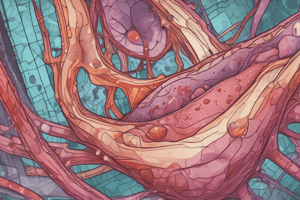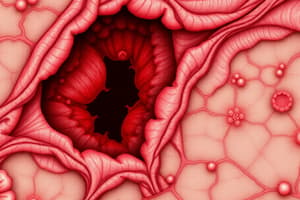Podcast
Questions and Answers
Which cells are primarily involved in the initial inflammatory response to a wound?
Which cells are primarily involved in the initial inflammatory response to a wound?
- Fibroblasts and lymphocytes
- Neutrophils and B-cells
- Eosinophils and platelets
- Polymorphs and macrophages (correct)
What is the role of exudate in the wound healing process?
What is the role of exudate in the wound healing process?
- To provide a dry environment for cell migration
- To form scar tissue exclusively
- To facilitate the diffusion of healing factors and support cell proliferation (correct)
- To increase the risk of infection
During which stage of wound healing is angiogenesis significantly involved?
During which stage of wound healing is angiogenesis significantly involved?
- Inflammatory phase
- Hemostasis phase
- Maturation phase
- Proliferation phase (correct)
How does fibronectin contribute to the wound healing process?
How does fibronectin contribute to the wound healing process?
What defines regeneration in the context of tissue repair?
What defines regeneration in the context of tissue repair?
Which type of tissue cells primarily mediate matrix deposition during the healing process?
Which type of tissue cells primarily mediate matrix deposition during the healing process?
What is the primary function of macrophages in the early stages of wound healing?
What is the primary function of macrophages in the early stages of wound healing?
What occurs immediately after hemorrhage in the tissue healing process?
What occurs immediately after hemorrhage in the tissue healing process?
What is the primary goal of the regeneration process in terms of tissue restoration?
What is the primary goal of the regeneration process in terms of tissue restoration?
In the context of regeneration, what role do instructive signals play?
In the context of regeneration, what role do instructive signals play?
Which type of cells is primarily responsible for the inflammatory response during tissue injury?
Which type of cells is primarily responsible for the inflammatory response during tissue injury?
How does the regenerative capacity differ between lower vertebrates and mammals?
How does the regenerative capacity differ between lower vertebrates and mammals?
What is the significance of fibroblasts in the wound healing process?
What is the significance of fibroblasts in the wound healing process?
What potential risk is associated with the regenerative process?
What potential risk is associated with the regenerative process?
What is a key factor in the effectiveness of the regenerative response in adult mammals?
What is a key factor in the effectiveness of the regenerative response in adult mammals?
What does morphostasis refer to in the context of regeneration?
What does morphostasis refer to in the context of regeneration?
Which statement accurately describes the initial response to tissue damage?
Which statement accurately describes the initial response to tissue damage?
What is the primary role of fibroblasts during the regeneration phase?
What is the primary role of fibroblasts during the regeneration phase?
Which cell type is primarily responsible for the acute inflammatory response following tissue injury?
Which cell type is primarily responsible for the acute inflammatory response following tissue injury?
What is a characteristic of aberrant tissue repair?
What is a characteristic of aberrant tissue repair?
During tissue regeneration, which process is primarily responsible for reducing chronic inflammation?
During tissue regeneration, which process is primarily responsible for reducing chronic inflammation?
In contrast to neonates, adult mammals primarily exhibit what type of cardiac response to injury?
In contrast to neonates, adult mammals primarily exhibit what type of cardiac response to injury?
What defines the process of matrix deposition during tissue repair?
What defines the process of matrix deposition during tissue repair?
Which sequence correctly depicts the phases involved in wound healing and tissue repair?
Which sequence correctly depicts the phases involved in wound healing and tissue repair?
Flashcards
Regeneration definition
Regeneration definition
Regeneration is the restoration of lost or damaged cells, tissues, and organs to their original structure and function.
Regeneration process requirements
Regeneration process requirements
Successful regeneration needs recognition of missing parts, proper integration between newly formed and existing tissues, regulated cell division, and signals that indicate the process is complete.
Regeneration and Cancer
Regeneration and Cancer
Regeneration has a potential link to cancer-related cellular abnormalities.
Vertebrate cardiac regeneration
Vertebrate cardiac regeneration
Signup and view all the flashcards
Adult mammal regeneration
Adult mammal regeneration
Signup and view all the flashcards
Morphostasis in Regeneration
Morphostasis in Regeneration
Signup and view all the flashcards
Cellular Guidance & Termination in Regeneration
Cellular Guidance & Termination in Regeneration
Signup and view all the flashcards
Regeneration versus Repair
Regeneration versus Repair
Signup and view all the flashcards
Regenerative response in neonates
Regenerative response in neonates
Signup and view all the flashcards
Adult mammalian heart response to injury
Adult mammalian heart response to injury
Signup and view all the flashcards
Regeneration vs. Repair
Regeneration vs. Repair
Signup and view all the flashcards
Healthy tissue (monocytes/neutrophils)
Healthy tissue (monocytes/neutrophils)
Signup and view all the flashcards
Damaged tissue (monocytes/neutrophils)
Damaged tissue (monocytes/neutrophils)
Signup and view all the flashcards
Tissue Regeneration (cells)
Tissue Regeneration (cells)
Signup and view all the flashcards
Aberrant tissue repair
Aberrant tissue repair
Signup and view all the flashcards
Treg cells in tissue regeneration
Treg cells in tissue regeneration
Signup and view all the flashcards
What are the stages of wound healing?
What are the stages of wound healing?
Signup and view all the flashcards
What does exudate do in wound healing?
What does exudate do in wound healing?
Signup and view all the flashcards
What is the initial phase of wound healing?
What is the initial phase of wound healing?
Signup and view all the flashcards
What is regeneration?
What is regeneration?
Signup and view all the flashcards
What is repair?
What is repair?
Signup and view all the flashcards
Why is the liver special in regeneration?
Why is the liver special in regeneration?
Signup and view all the flashcards
What are some examples of skin damage?
What are some examples of skin damage?
Signup and view all the flashcards
How does angiogenesis contribute to wound healing?
How does angiogenesis contribute to wound healing?
Signup and view all the flashcards
Study Notes
Tissue Repair and Regeneration (MEDC0064-TRAR)
- This course covers human skin wound healing, tissue repair and principles of regeneration.
- The course is led by Prof Krista Rombouts, PhD from UCL Institute for Liver and Digestive Health, Regenerative Medicine & Fibrosis Group, Royal Free Hospital, London, UK.
Learning Objectives
- Understand injury, cellular, and vascular responses.
- Sequence in wound healing
- Definitions of Regeneration and Repair
- Liver and regeneration
Examples of Skin Damage
- Sunburn/UV
- Burning wounds
- Itchy wounds (bacterial/nutritional)
- Psoriasis (chronic autoimmune disease)
- Benign skin cancers
- Malignant skin cancers
Steps in Repair by Scar Tissue Formation
- Inflammatory response: removal of damaged/dead tissue via polymorphs and macrophages.
- Proliferation: migration and proliferation of parenchymal and connective tissue.
- Formation of new blood vessels (angiogenesis) and granulation tissue. (this occurs over a timeframe of hours, days, weeks and months)
A Temporal Journey for Normal Wound Healing
- Includes various stages such as coagulation, inflammation, proliferation, and maturation/remodeling.
- Each stage has a specific timeframe (minutes, hours, days, weeks, months, years) with various cellular and biological processes involved.
Wound Healing Exhibits a Defined Sequence
- Starts with hemorrhage into tissues resulting in formation of a fibrin clot.
- Macrophages recruit to process cell remnants and damaged ECM
- Fibronectin, cell debris, and bacterial products attract other cells.
- The extra-cellular matrix (ECM) is deposited at the wound site.
- Temporary matrix is removed and replaced by one rich in collagen.
Characteristics of Skin Wounds
- Cell migration relies on chemical signals and the extracellular matrix.
- Leukocytes migrate rapidly by forming focal adhesions.
- Polymorphonuclear leukocytes are rapidly recruited within the first day.
- Macrophages arrive after neutrophils and persist for days, phagocytosing debris and releasing cytokines/chemoattractants.
Cells in Skin Wounds
- Fibroblasts, myofibroblasts, pericytes, smooth muscle cells: responsible for fibroplasia, matrix production, wound contraction, strength; recruited by day 3/4
- Endothelial cells: form capillaries for nutrient/gas exchange, delivery of inflammatory cells; visible beyond day 3.
- Epithelial cells: migrate across wound surface, through provisional matrix, using stromal collagen
- Stem cells: provide epidermal/dermal cells; regenerate skin structures (hair follicles, glands; found in bone marrow, hair follicles, basal epidermal layer)
Pro-inflammatory and Anti-inflammatory Cells
- Neutrophils & mast cells: first responders, important for innate immune response for wound detection, executing rapid response and restoring tissue homeostasis
- Mast cells: early participant in innate immune system, releasing effector molecules (chemoattractants) to recruit eosinophils/monocytes
- Macrophages: pivotal for fighting pathogens and tissue healing
- M1 macrophages: pro-inflammatory phenotype.
- M2 macrophages: wound-healing phenotype; activated after acute phase of tissue injury
- Regulatory T (Treg) cells: key player in adaptive immune response after tissue injury; contributing to tolerance.
Chemokines in Wound Healing
- Early: promotion of inflammation (neutrophils, macrophages) and increase neovessel formation
- Late: promote scar formation, regression of neovessels, and the termination of the inflammatory response.
Normal vs. Aberrant Regeneration (Examples: Liver Regeneration)
- Normal early response: rapid cell proliferation, restoration of liver size/function
- Aberrant regeneration: slow, less efficient cell restoration (e.g., in chronic liver diseases like fatty liver), potential for scar development and organ function loss
- Liver regeneration: involves distinct phases (priming, proliferation, termination), relies on cell-cell communication (signals like TGF-beta, IL-6), regulated by the precise coordination of various cell types including hepatocytes and non-parenchymal cells.
Regenerative Capacity Across Species
- Different species exhibit varying capacities for tissue regeneration.
- Examples in lower vertebrates vs mammals demonstrate the species-dependent regenerative abilities.
Studying That Suits You
Use AI to generate personalized quizzes and flashcards to suit your learning preferences.





